Abstract
Sound is “an alternation in pressure, particle displacement, or particle velocity propagated in an elastic material” (Olson, 1957). Alternatively, sound can be defined as a mechanical wave that is produced from pressure change and is propagated through a solid, liquid, or gas, comprising of frequencies within the level of perception of the ear (roughly between 20 and 20,000 Hz). Sound is produced through a progression of mechanical compressions and rarefactions of mechanical waves that consecutively propagate through a flexible solid, liquid, or gas media. We encounter sound at almost every aspect of our life, musical instruments, radio and television, wind, vehicles horns etc. sound is measured in decibels.
Characteristics of Sound
Sound travels through a medium known scientifically as medium. The density of medium through which sound is propagated affects the ease, distance, and speed at which sound travels, that is, the velocity of transmission of sound is inversely proportional to the density of the medium. Sounds can be characterized using various criteria, for example, we can use amplitude, frequency, and velocity to characterize sound. Each sound possesses a definite frequency. Amplitude is the degree of sound pressure alteration within a single wave while sound velocity is the speed of propagation of sound waves.
Sounds can also be categorized using pitch, quality, and loudness, all of which affect the perceptivity of the sound by the ear. Pitch is directly proportional to frequency: high frequencies produce high pitches and vice versa. It is worth noting that high frequency sounds, such as that produced by a bat, are not easily perceived by the human ear. Sound quality refers to the ability of the human ear to pick out all parts of a sound, for example, a tuning fork produces sound of a single frequency and can be easily picked out by the ear. Loudness is a characteristic of the sound that varies with sound pressure and determines whether a sound is classified as noise.
The behavior of sound waves is affected by three factors:
- Density and pressure- both of these parameters are affected by temperature and determine the speed of sound.
- Motion of the medium, for instance, if sound is propagated through moving water, then it affects the speed and distance of travel.
- The density of the medium.
Mathematical representation of longitudinal waves
Sound waves are propagated through various media as longitudinal waves. In a longitudinal wave, the direction of vibration of the individual portions of the wave is parallel to the direction of the travel of the wave. This is similar to the movement of a slinky spring. Sound waves move as longitudinal waves since individual components of the medium through which the waves travel through move parallel to those of the sound waves. The graphical representations below illustrate the longitudinal nature of sound waves.
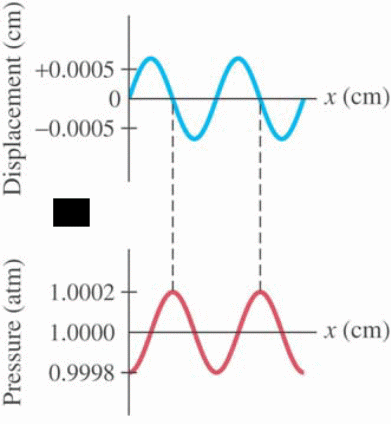
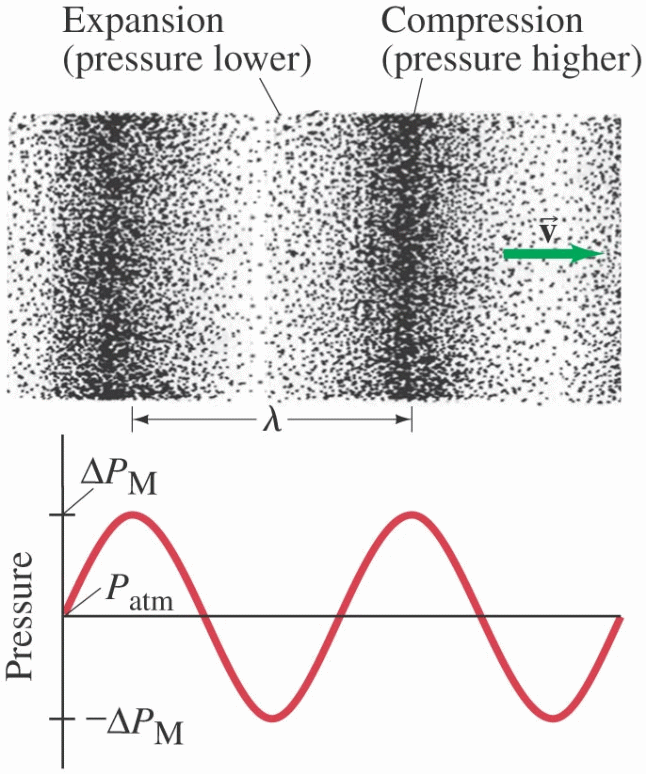
Longitudinal wave can be presented mathematically as shown below:
Consider a small cylinder within the media of propagation of sound waves shown,
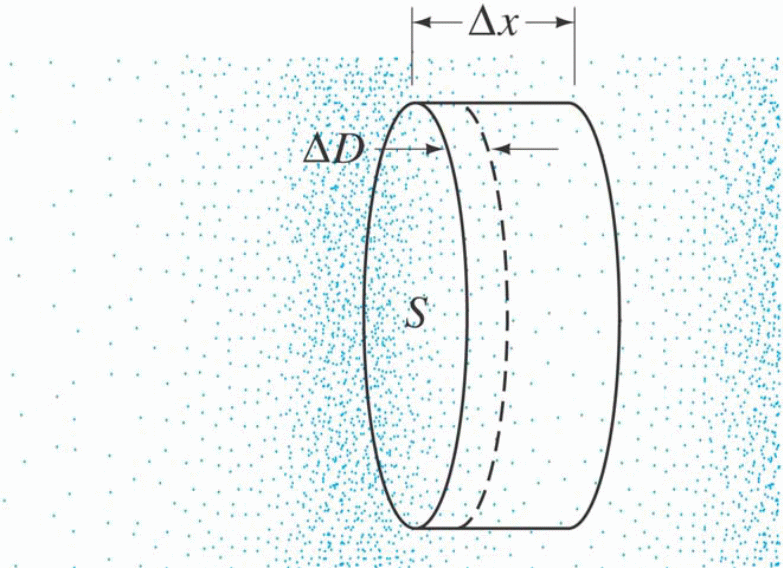
Then, change in pressure is given by ΔP= -B x ∂D/∂x, if the displacement is sinusoidal, then, ΔP = – (BAk)cos(kx-ωt), where υ=√B/p and υ= ω/k.
Intensity of sound
Sound intensity (I) is the sound power per unit area and is usually measured in the context of the listener’s position. I is measured in watts/m2 or watts/cm2 and the quantities are normally measured relative to a standard “threshold of hearing Intensity”, denoted as I0.

The most frequently used unit in measuring sound intensity is Decibels (dB).

The decibel is a logarithmic notation that notates the proportion of a physical quantity in comparison to a standard reference. A dB is equal to one tenth of a bel (B), and the factor of ten used in the logarithmic notation changes it to decibels rather than bels, and is used because 1 dB is the ‘just noticeable difference’ in sound intensity for the ear.
The decibel is applied in a variety of scientific dimensions and this is attributed to its ability to expediently represent a wide range of measurements, and the ability to undertake simple mathematical operations. The unit is regularly used together with a suffix which illustrates the reference quantity that has been applied, for instance, dBm shows that the reference unit is the milliwatt.
The logarithm notation is expressed as a threshold of hearing intensity, for instance, if I= 10,000 multiplied by the threshold, then the ratio of I to I0 is 104, and the sound intensity is 30dB, that is:
I(dB)= 10 log10 (10,000/I0) = 10 x 4= 40 dB
Decibel units provide a comparative measure of sound intensity, and the fact that it is based on the powers of ten gives measures that can be worked with easily, neither too large nor too small. This makes it possible to cover a wide range of sounds that can be perceived by the human ear. Another factor that necessitates the use of logarithms to the base of ten is the rule of thumb for loudness. The rule states that for a sound to double its loudness, the intensity has to be raised ten times.
Sources of sound
Sound is produced in almost every aspect of our life, however, studies of sound waves are normally undertaken using vibrating strings, tuning forks and air columns. Other sources of sound include vibrating strings, vibrating membranes such as drums, and vibrating air columns. Vibration of these instruments may be achieved by plucking, striking or blowing and the sounds produced from the instruments pass through the air before reaching our ears. Vibrating strings produce three types of waves: fundamental or first harmonic, first overtone or second harmonic, and at the second overtone or third harmonic. Stringed instruments produce sound by plucking, this involves fingering the strings to reduce their length, this increases the pitch of the sound produced. Pitch can also be altered by using a cords of varying thickness. To amplify the sound produced by using a sounding board or box. The sound can also be amplified using electronic devices (Davis and Patronis, 2006).
Quality of Sound, and Noise; Superposition
One may wonder why a trumpet and a flute sound so differently. The answer to the question is explained using overtones: the types of overtones present and their strength. An overtone is a section of a wave that can either be a harmonic partial or inharmonic partial (Giancoli, 2009). Some instruments produce overtones that are to some extent sharper or flatter than proper harmonics. This is shown below:
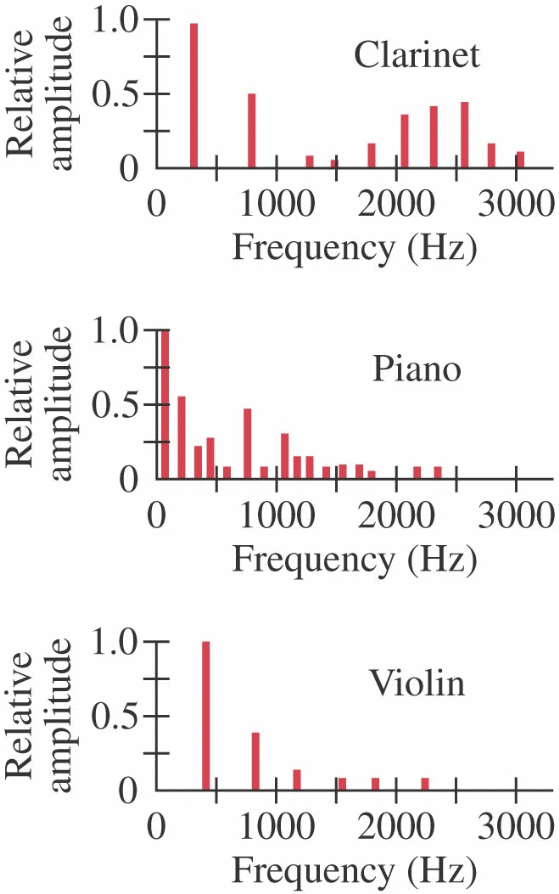
Interference of Sound Waves
Wave interference is an occurrence that is observed when two waves travelling through the same medium come into contact. The interference process can occur in two ways. Constructive interference occurs when two waves travelling in opposite directions through a similar medium meet and their amplitudes add onto each other. In contrast, a destructive interference occurs when two waves travelling in opposite directions through a similar medium meet and cancel out, this occurs when one of the waves is upward displaced and the second is downward displaced (Giancoli, 2009). This is shown below:
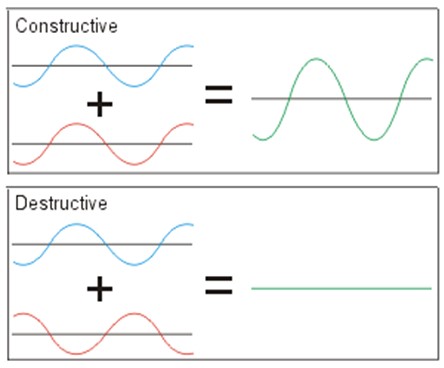
Wave interference is used to make beats used to produce music (Rumsey and McCormick, 2009) Two waves with different frequencies may interfere constructively, that is, the crests and troughs will not interact in a similar way with each new wave since they are moving at different velocities. Hence, the waves interfere both constructively and destructively, this is referred to as beats and is illustrated below.
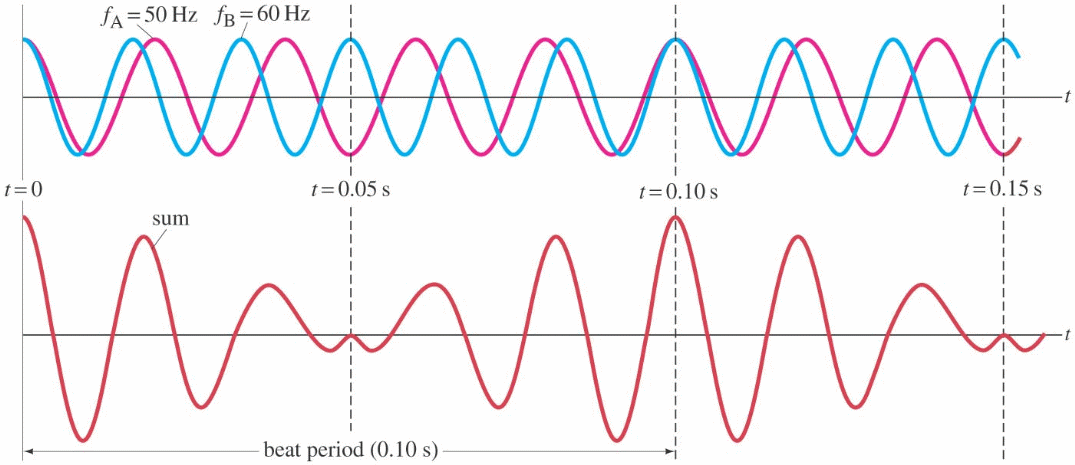
Doppler Effect
The Doppler Effect is defined as the alteration of frequency of a wave experienced by a person moving relative to the source of the sound. The observation was first noted by Christian Doppler in 1842 and is frequently illustrated by an approaching car with its sirens on. As the car approaches an observer, passes, and moves away from him, the frequency increases and drops as the car moves away.
The relative rise in frequency of the approaching car is explicated as follows:
As the car moves nearer, each succeeding wave crest is produced from a location closer to the observer. Hence, the time taken by consecutive waves to reach the observer increases steadily (Giancoli, 2009). Hence, the time of arrival of consecutive waves at the observer is decreased and this lowers the frequency of the sounds. When the car moves away, the distance between consecutive crests reduces steadily, hence, the arrival time between two successive waves increases, lowering the frequency. The distance between consecutive waves rises. The phenomenon may also result from the movement of the observer, or the relative movement of both entities. In the latter case, the effects are calculated separately. This observation can be presented mathematically as shown below:
f = (υ -υr/υ +υs) f0, where
- υ is the velocity of waves from the source
- υr is the velocity of the observer in comparison to the source
- υs is the velocity of the observer in comparison to the source
- f is the frequency at the observer’s position
- f0 is the frequency of the waves at the source’s position
If the observer is stationary, then υr becomes zero and change of frequency is only determined by the motion of the source of waves. The frequency decreases steadily if either of the two entities moves away from each other, and vice versa.
Shock waves and sonic boom
Shock waves can be compared to bow waves generated when a boat moves faster than the speed of water as shown below;

A similar phenomenon occurs when an aircraft moves at speeds exceeding the speed of air. This creates two sonic booms, one in front and one behind. Sonic booms produce large amounts of sound energy and the resulting sound resembles a huge blast. The explanation for the occurrence is as follows:
When a plane passes through air, it generates pressure waves in front and behind it. These waves move at the speed of sound, as the aircraft’s speed rises, the front waves merge with those at the back, producing a very loud sound.
Application of Sound Waves: sonar, ultra sound, medical imaging
Sound waves are used in several technologies. While the range of human hearing is between 20 and 20,000 Hz, frequencies below or above this range are still useful to man. Sound waves above 20,000Hz are known as ultrasonic waves, while the human ear cannot perceive these sounds, they are applied in sonar systems, sonograms, surgical instruments, and cleaning items (Giancoli, 2009). Some animals and insects also produce ultrasonic sounds and this helps them to hunt for food and in vision on the dark (echolocation).
Another application, known as digital imaging, is a technique that is used to create images of the body parts for medical use. There are various forms of digital imaging technologies, these include medical radiography, magnetic resonance imaging (MRI), photoacoustic imaging and medical ultrasonography (ultrasound). Medical ultrasound utilizes high frequency sound waves to produce 3D images. This technology is commonly used for observing fetus in pregnant women and animals and observing certain body organs such as the kidney and liver.
A third application of ultrasonic waves is in a technology known as Sonar (SOund NAvigation Ranging). Sonar technology is used in navigation (ocean exploration etc), weather prediction, tracking the movements of aircraft, ships, submarines, rockets. Geologists also use this technology to assist them in oil exploration and tracking earthquakes.
References
Davis, D., and Patronis, E. (2006). Sound system engineering. Oxford: Focal Press.
Giancoli, D. C. (2009). Physics For Scientists And Engineers With Modern Physics, Fourth Edition. NJ: Pearson Prentice Hall.
Olson, H. F. (1957). Music, physics and engineering. Ontario: Dover Publications.
Rumsey, F., McCormick, T. (2009). Sound and Recording. Oxford: Elsevier Ltd.